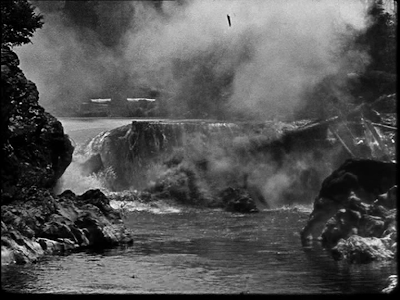Full Throttle War
Gilles Deleuze
Cinema 1
Cinéma 1
Ch X. The Action-Image: The Small Form
Ch X. L'image-action : La petite forme
3c.
The Paradox of Keaton the Minoring and Recurrent Functions of the Great Machines
Le paradoxe de Keaton : la fonction minorante et récurrente des grandes machines
At the same time, a type of images which are unexpected in the burlesque rise up before our very eyes. For example, the opening sequence of Our Hospitality, with the night, the thunderstorm, the lightning, the double murder and the terrified woman: pure Griffith. Also the cyclone in Steamboat Bill Junior, the diver's suffocation at the bottom of the sea in The Navigator, the crushing of the train and the flood in The General, the terrible boxing match in Battling Butler. Occasionally it is, in particular, an element of the image: the sabre-blade about to be thrust into an enemy's back, in The General, or the knife which the The Cameraman slips into the hand of a Chinese demonstrator. [Deleuze, Cinema 1, 1986: 177-178]
En même temps, sous nos propres yeux, naissent un type d’images inattendues dans le burlesque. C’est l’ouverture des « Lois de l’hospitalité » avec la nuit, l’orage, les éclairs, le double meurtre et la femme terrifiée, du pur Griffith. C’est aussi le cyclone de « Steamboat Bill Junior », l’asphyxie du scaphandrier au fond de la mer dans « La croisière du Navigator », l’écrasement du train et l’inondation dans « Le mécano de la General », le terrible combat de boxe de « Battling Butler ». Parfois, c’est particulièrement un élément de l’image : la lame du sabre qui vient s’enfoncer dans le dos d’un ennemi, dans « Le mécano de la General », ou bien le couteau que « Le caméraman » glisse dans la main d’un manifestant chinois. [Deleuze Cinéma 1, 1985: 237c.d]
Likewise in The General, one should not just think that the girl who feeds the train's boiler with little pieces of wood is behaving in a clumsy and inept way. This is of course true, but she also brings to realisation Keaton's dream of taking the biggest machine in the world and making it work with the tiniest elements, thus converting it for the use of each one of us, making it the property of everyone. [Deleuze, Cinema 1, 1986: 180c]
De même, dans « Le mécano de la General », on ne croira pas seulement que la jeune fille, alimentant la chaudière du train avec de tout petits morceaux de bois, se conduit de manière maladroite et inadaptée. C’est pourtant vrai, mais elle réalise aussi le rêve de Keaton, prendre la plus grande machine du monde pour la faire marcher avec de tout petits éléments, la convertir ainsi à l’usage de chacun, en faire la chose de tout le monde. [Deleuze Cinéma 1, 1985: 240-241]
En même temps, sous nos propres yeux, naissent un type d’images inattendues dans le burlesque. C’est l’ouverture des « Lois de l’hospitalité » avec la nuit, l’orage, les éclairs, le double meurtre et la femme terrifiée, du pur Griffith. C’est aussi le cyclone de « Steamboat Bill Junior », l’asphyxie du scaphandrier au fond de la mer dans « La croisière du Navigator », l’écrasement du train et l’inondation dans « Le mécano de la General », le terrible combat de boxe de « Battling Butler ». Parfois, c’est particulièrement un élément de l’image : la lame du sabre qui vient s’enfoncer dans le dos d’un ennemi, dans « Le mécano de la General », ou bien le couteau que « Le caméraman » glisse dans la main d’un manifestant chinois. [Deleuze Cinéma 1, 1985: 237c.d]
Likewise in The General, one should not just think that the girl who feeds the train's boiler with little pieces of wood is behaving in a clumsy and inept way. This is of course true, but she also brings to realisation Keaton's dream of taking the biggest machine in the world and making it work with the tiniest elements, thus converting it for the use of each one of us, making it the property of everyone. [Deleuze, Cinema 1, 1986: 180c]
De même, dans « Le mécano de la General », on ne croira pas seulement que la jeune fille, alimentant la chaudière du train avec de tout petits morceaux de bois, se conduit de manière maladroite et inadaptée. C’est pourtant vrai, mais elle réalise aussi le rêve de Keaton, prendre la plus grande machine du monde pour la faire marcher avec de tout petits éléments, la convertir ainsi à l’usage de chacun, en faire la chose de tout le monde. [Deleuze Cinéma 1, 1985: 240-241]
Deleuze, Gilles. Cinema 1: The Movement-Image.Transl. Hugh Tomlinson & Barbara Habberjam, London: Continuum/The Athlone Press, 1986.









No comments:
Post a Comment